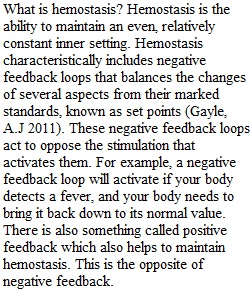


Q Module 1Critical Thinking Assignment Homeostatic Mechanism Homeostasis is the ability of an organism to maintain a relatively constant internal environment with fluctuations occurring around an ideal set point. Homeostasis works much like a thermostat with changes in a variable such as temperature being detected by a receptor. A control center receives the information, assesses how far from the set point a change may be, and initiates a response to return the system back toward the set point. The effector brings about that change. Homeostasis is a very important concept in physiology because all cells, tissues, organs and organ systems are designed to maintain homeostasis for optimal health and functioning. The usual mechanism for returning systems to homeostasis is negative feedback, but there are some examples of positive feedback that serve important functions in the body. • Begin your paper by explaining what negative feedback is and how it works to maintain homeostasis. Compare this mechanism to positive feedback. • Using blood glucose control as an example, explain how negative feedback works to keep blood glucose levels relatively constant. Contract this to positive feedback, using labor and childbirth as your example. • What is the stimulus, receptor, control center and effector for each of these examples? • Discuss another example of a homeostatic system in the human body that is regulated by negative feedback. Requirements: • Your paper should be 2-3 pages in length, excluding title and reference pages. • Include at least two scholarly references, in addition to the course textbook. Also cite your sources in the body of the paper. The following link to the CSU Global Writing Center provides more information on how to find scholarly sources. • Conform to the APA guidelines in the CSU Global Writing Center. • The CSU Global Library is a good place to find these references. Rubric BIO200 Mod 1 CT BIO200 Mod 1 CT Criteria Ratings Pts This criterion is linked to a Learning OutcomeContent 10 to >8.0 pts Meets Expectation Demonstrates strong or adequate knowledge of homeostasis and anatomical terminology; correctly represents knowledge from the readings and sources. 8 to >6.0 pts Approaches Expectation Some significant, but not major, errors or omissions in demonstration of knowledge. 6 to >4.0 pts Below Expectation Major errors or omissions in demonstration of knowledge. 4 to >0 pts Limited Evidence Fails to demonstrate knowledge of the materials. 10 pts This criterion is linked to a Learning OutcomeSources / Examples 5 to >4.0 pts Meets Expectation Sources or examples meet required criteria and are well chosen to provide substance and perspectives on the issue under examination. 4 to >3.0 pts Approaches Expectation Sources or examples meet required criteria, but are less than adequately chosen to provide substance and perspectives on the issue under examination. 3 to >2.0 pts Below Expectation Sources or examples meet required criteria, but are poorly chosen to provide substance and perspectives on the issue under examination. 2 to >0 pts Limited Evidence Source or example selection and integration of knowledge from the course are clearly deficient. 5 pts This criterion is linked to a Learning OutcomeDemonstrates college-level proficiency in organization, grammar and style. 5 to >4.0 pts Meets Expectation Project is clearly organized, well written, and in proper format as outlined in the assignment. Strong sentence and paragraph structure; few errors in grammar and spelling. 4 to >3.0 pts Approaches Expectation Project is fairly well organized and written, and is in proper format as outlined in the assignment. Reasonably good sentence and paragraph structure; significant number of errors in grammar and spelling. 3 to >2.0 pts Below Expectation Project is poorly organized; does not follow proper paper format. Inconsistent to inadequate sentence and paragraph development; numerous errors in grammar and spelling. 2 to >0 pts Limited Evidence Project is not organized or well written, and is not in proper paper format. Poor quality work; unacceptable in terms of grammar and spelling. 5 pts This criterion is linked to a Learning OutcomeDemonstrates proper use of APA style 5 to >4.0 pts Meets Expectation Project contains proper APA formatting, according to the CSU-Global Guide to Writing and APA, with no more than one significant error. 4 to >3.0 pts Approaches Expectation Few errors in APA formatting, according to the CSU-Global Guide to Writing and APA, with no more than two to three significant errors. 3 to >2.0 pts Below Expectation Significant errors in APA formatting, according to the CSU-Global Guide to Writing and APA, with four to five significant errors. 2 to >0 pts Limited Evidence Numerous errors in APA formatting, according to the CSU-Global Guide to Writing and APA, with more than five significant errors. 5 pts Total Points: 25 PreviousNext
View Related Questions